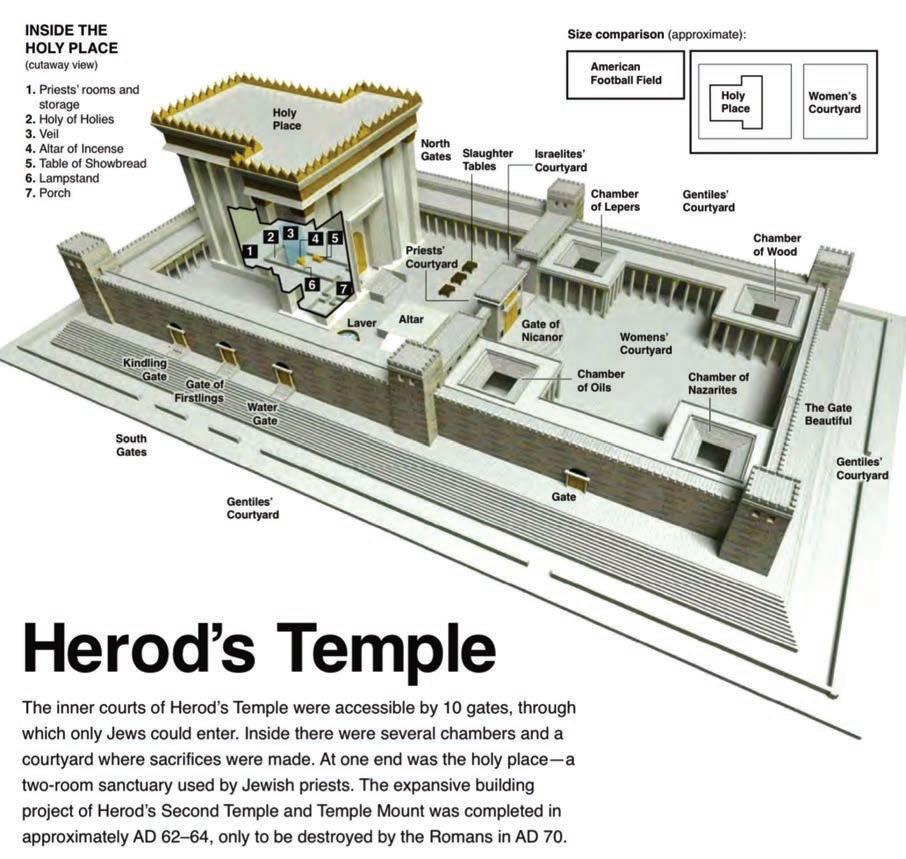
8 minute read
Of Temples and Men: the Temple of God's Glory in Jerusalem
Dr. Aristeides Papadakis
Dr. Papadakis is Professor of History (Emeritus) at the University of Maryland. He is the author of Crisis in Byzantium: The Filioque Controversy in the Patriarchate of Gregory II of Cyprus (Crestwood, N.Y.: St. Vladimir’s Seminary Press, 1997) and, in collaboration with Fr. John Meyendorff, The Christian East and the Rise of the Papacy: The Church 1071–1453 A.D (Crestwood, N.Y.: St. Vladimir’s Seminary Press, 1994), which has been translated into French, Greek, Russian, and Hungarian. He was also a contributor and consultant to the Oxford Dictionary of Byzantium (three volumes) and a frequent participant in international conferences addressing the history, theology, and current state of the Orthodox Church.
Advertisement
The temple of Solomon, that magnificent construction, was built on earth according to the heavenly pattern revealed to David (1 Chronicles 28:11–12, 18–19) – just as the tent had been erected according to the pattern revealed to Moses on Sinai (Exodus 25:9, 40; Numbers 8:4). When it was consecrated, “the glory of the LORD filled the temple of God” (2 Chronicles 5:14); it was nevertheless desecrated and destroyed by the Babylonians in 587/586 B.C. “Nebu′zaradan, the captain of the bodyguard, a servant of the king of Babylon … burned the house of the Lord, and the king’s house and all the houses of Jerusalem; every great house he burned down. … And the pillars of bronze that were in the house of the Lord, and the stands and the bronze sea that were in the house of the Lord, the Chaldeans broke in pieces, and carried the bronze to Babylon. And they took away the pots, and the shovels, and the snuffers, and the dishes for incense and all the vessels of bronze used in the temple service, the firepans also, and the bowls. What was of gold the captain of the guard took away as gold, and what was of silver, as silver (2 Kings 25:8–15).
The Second Temple, rebuilt when the people were allowed to return from the Babylonian captivity, was eventually renovated extensively by Herod the Great (73–4 B.C). It is of that stunning temple that the disciples remarked, “Look, Teacher, what wonderful stones and what wonderful buildings!” (Mark 13:1). Later Rabbis said, “Whoever has never seen the temple of Herod has never seen a beautiful building” (Babylonian Talmud, Sukkah 51b). As a matter of fact, the Emperor Titus himself stated that he would prefer not to destroy the Temple, as it constituted “the ornament of the Empire.” Nevertheless, in 70 A.D. Titus gave order for the Roman army to thoroughly demolish the entire city and temple (Josephus, Wars 6.4.3; 7.1).

THE TEMPLE OF HOLY WISDOM IN CONSTANTINOPLE
The historian Cyril Mango once suggested that the world-famous Hagia Sophia – the Church of the Holy Wisdom – built by the Emperor Justinian, was the bridge that linked the early Christian period to the Byzantine Middle Ages.1 That it marked the end of the ancient world there is little doubt. A new era in the development of Christian architecture was to follow. Indeed, the emperor was widely recognized as a great builder. He is said to have built several dozen churches in Constantinople itself, not to mention other equally important projects elsewhere. Some of these buildings on a large scale are well-documented, even highly praised. The Transfiguration in the apse of the monastery of St. Catherine’s on Sinai, say, is an example, as are the mosaics of San Vitale in Ravenna.
The church that the emperor built in the middle of Constantinople, as the city’s main cathedral, undoubtedly ranks among his great achievements, second only to what he was able to realize in the area of Roman law, which until recently had influenced much of Europe. As we should expect, the exterior of the building (dedicated on December 2, 537) is impressive, even monumental, as it dominates the city’s skyline. To paraphrase Edward Gibbon, it was the residence as well as the workmanship of the Deity. As for the overall structure itself, we need only add, surprisingly, that it is not a circular building, but a central dome placed on a somewhat large square ground. It is not at any rate a “domed basilica,” even if it is described frequently in this way. The church that best fits this description is St. Irene, which is Hagia Sophia’s next-door neighbor.

Arguably, in contrast to its façade, it is the interior that is all-important, even overwhelming. The Nika riots which caused the previous Hagia Sophia to collapse in flames (532) was in fact a traditional rectangular basilica that had served its purpose. This became obvious and before long its replacement began in earnest, though it turned out to be substantially different in shape. It took five years for its completion. Its main architects were Anthimos of Tralles and Isidore of Miletus. Not surprisingly, neither architect failed to heed Justinian’s suggestions. Both were doubtless fully aware of his fame as builder of not only fortresses and monasteries, but of palaces and bridges, baths and churches. It seems rules were ignored at every stage to accommodate the emperor’s own ideas.
What at once amazes visitors above all is the presence of pure light that encloses the entire building. This was in part due to the incomparable dome that reaches 183 feet above the ground. It surpassed the ancient Roman Pantheon by 40 feet. Surprisingly, the typical visitor was often convinced that the dome was suspended from above without anyone’s assistance. Actually, the light was diffused by the dome’s countless windows resting at its base. It is significant that the dome is high, broad, and heavy. Yet it manages to transfer its considerable weight onto four pendentives and a number of huge columns. Moreover, the columns are able to provide a further explosion of light with their multicolored marble. As the great Peter Brown recently insisted, these same columns slowly come alive “like a meadow in full flower.”2 Indeed, the columns, we should remember, are twice as high if compared with other well-known contemporary churches.
Looked at broadly, this was fearless architecture altogether. Its vast, impressive floor space under a single dome was remarkable enough, even daring. To conclude cautiously, we need only emphasize that the architectural strength of the dome lay in part with its windows, that have the ability to fill the interior with light. It goes without saying that structures of this type increasingly became symbols of heaven and in time were adorned with the image of the Christ Pantocrator. To this day this remains typical of such buildings. Scripture insists, of course, “that he who has seen Me has seen the Father” (John 14:9).
It remains to draw attention to the Byzantine mosaics that survive within the space of this building. Two are especially noteworthy and deserve mention.
The first is the huge mosaic of the Panagia enthroned with the Christ Child. It can be described as delicate and awesome. It was praised at length by Patriarch Photios, who was in attendance at its dedication (Ninth Century.) The other is also a mosaic of the Deesis and is, in its simple, silent beauty, no less extraordinary (Thirteenth Century.) That such art could exist, and flourish, is a marvel in the life of a late and exhausted Byzantine Empire. Both are accessible through the upper gallery.
On the May 29, 1453, the Byzantine Empire collapsed and the Church of the Holy Wisdom, as we should expect, became a mosque. After the long Ottoman period (the familiar Tourkokratia), the building was transformed into a museum (1934). By order of Mustafa Kemal of Turkey, the mosque of the Haya Sophia was closed. Clearly, its one hundredth anniversary as a museum will become a reality in 2037. That it is to an unusual degree appropriate, even timely, that this should be honored is obvious. The Emperor Justinian would indeed be very proud. We need to recall that at its dedication, he shouted for all to hear, “Solomon, I have surpassed you.” Evidently, his supreme self-confidence had yet to leave him.
“KNOW YE NOT…?”: THE CHALLENGE OF BECOMING TEMPLES
In defiance of the countless calls and interventions coming from the United Nations Committee on Antiquities, from numerous governments and cultural and religious agencies, the Turkish authorities have remained inflexible in their decision to re-convert Hagia Sophia into a mosque. On Friday July 24, 2020, President Erdogan spoke triumphantly about “Hagia Sophia breaking away from its chains of captivity.” Shortly thereafter, the Muslim prayer service was conducted in the Hagia Sophia, now covered in turquoise carpets, with its ancient mosaics obscured by white drapes. The call to prayer, ringing out from the minarets, had drawn in an excited crowd in the hundreds of thousands. In the words of the new sultan, “This was the greatest dream of our youth. It was the yearning of our people and it has been accomplished.”
Solomon is forever remembered for his wisdom and for erecting the Temple in Jerusalem. Justinian will be remembered as the emperor who built Holy Wisdom, one of the most important buildings in European history, and part of the precious triptych that also includes the Parthenon in Athens and St. Peter’s in Rome. For better or worse, Mehmed II, Kemal Mustafa Atatürk, and now Recep Tayyip Erdogan have also etched their names into humanity’s memory of Hagia Sophia.
We do, as we must, lament the vicissitudes of our times, the destruction, abuse, or neglect of the cultural patrimony that Christianity has offered the world over two millennia. But we should heed the admonishment of the Prophet Jeremiah, which also applies to us: “Do not trust in these deceptive words: ‘This is the temple of the Lord, the temple of the Lord, the temple of the Lord!’” (Jeremiah 7:4). The Wisdom and Glory of God is not something we can ever possess, entombed in stone and gold, in order to boast of it, make our name great, and be deceived into feeling righteous and secure. It is also not in buildings and carvings and images, no matter how exquisite, that God’s Holy Wisdom and Glory resides. “Know ye not,” writes the Apostle, “that you are the temple of God and that God’s Spirit dwells in you? (1 Corinthians 3:16). Indeed, it is us that God has fashioned as “icons of his ineffable Glory,” unto “comeliness and beauty,” as we chant in the Funeral service.
Perhaps divine providence has placed before us a much greater challenge, by directing us to the one thing needful ....









